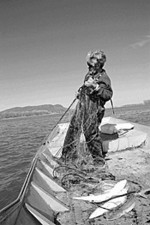The Missouri Department of Health and Senior Services has released its 2008 Fish Consumption Advisory for Missouri waterways. The pertinent disclaimer follows:
The 2008 consumption guidelines are based on the most recent fish sampling information available. Because not all waters in Missouri are monitored, this fish consumption advice is considered a baseline of protection. The advice balances risks from contamination with the benefits of eating fish. In general, eat smaller, legal-size, younger fish because they tend to have lower levels of contamination than larger fish of the same species.
Most of the recommendations are based on how often you should eat a certain fish (once a week or month). However, there are a few fish labeled "Do Not Eat", including sturgeon eggs from the Missouri and Mississippi rivers.
I mention the sturgeon eggs because three years ago my colleague Kristen Hinman wrote this article on the growing popularity of sturgeon eggs as a replacement for caviar.
The full text of the press release is after the jump.
For Immediate Release: February 28, 2008
Contact: Mary Kay Hager 573/751-6062
State Health Officials Provide New Guide to Eating Missouri Fish
Updated Guidelines Include Mercury, Lead, PCBs and Chlordane
Today the Missouri Department of Health and Senior Services (DHSS) issued the 2008 Fish Consumption Advisory, an annual report focusing on the benefits of eating fish, and which fish species should be eaten in limited quantities, or not eaten at all, due to environmental contaminants. The advisory is based on annual fish studies conducted at various Missouri lakes, rivers, and streams. The full advisory may be found at: http://www.dhss.mo.gov/fishadvisory/.
Annually, the DHSS evaluates the level of contaminants in fish to make sure they are safe to eat. All fish contain some small amount of chemical contaminants. In most instances and for most people, the health benefits of eating fish outweigh the potential health risks from contaminants. However, there are occasions when limited or even no consumption of fish is appropriate.
Released each year prior to Missouri's fishing season, the advisory provides consumption guidelines for locally caught fish, updates to the health effects of key contaminants, and advice on fish preparation to reduce contaminants prior to consumption. The 2008 consumption guidelines are based on the most recent fish sampling information available. Because not all waters in Missouri are monitored, this fish consumption advice is considered a baseline of protection. The advice balances risks from contamination with the benefits of eating fish. In general, eat smaller, legal-size, younger fish because they tend to have lower levels of contamination than larger fish of the same species.
Fish is a good source of high-quality protein and essential nutrients that contribute to a healthy diet. Fish is low in cholesterol, and some types of fish have omega-3 fatty acids that are essential for the development of the nervous system, may be beneficial in reducing heart disease, and may have other beneficial health effects.
Much of this year's fish advisory is unchanged from the 2007 version. There is a state-wide limited-consumption advisory for sensitive populations on all fish due to the presence of mercury. There are also a few advisories on fish from specific water bodies throughout the state due to the presence of PCBs and/or chlordanes. Fish from several streams in the Old Lead Belt region of southeast Missouri also continue to carry consumption advisories due to the presence of lead. Because of recent data, this year DHSS also added consumption advisories for Largemouth Bass greater than 12 inches and Buffalo greater than 16 inches taken from Simpson Park Lake in St. Louis County, MO, due to the presence of lead and chlordanes, respectively.
The advisory is provided for two groups of individuals: sensitive populations and all consumers. Sensitive populations include women who are pregnant, women of childbearing age, nursing mothers, and children under 13 years of age. Because growth and development occurs rapidly in fetuses and young children, some chemicals may affect them differently than adults. Thus, special consideration has been given to them during the development of the advisory.
Following is a brief summary of the DHSS 2008 Fish Consumption Advisory. Individuals are advised to eat no more than the recommended meal advice. (NOTE: One meal is 11 ounces for adults and 3 ounces for children under 13 years).
Advisory Group: Sensitive Populations
Key Contaminant: Mercury
Because of the potential risk mercury poses to the developing nervous system of fetuses and young children, DHSS is continuing to advise high-risk, sensitive populations, including women who are pregnant, who may become pregnant, nursing mothers, and children under 13 years of age, to limit fish consumption. DHSS recommends that all consumers be aware of the benefits of eating fish and the potential for adverse effects from mercury in fish to the central nervous and cardiovascular systems (see: http://www.epa.gov/mercury/effects.htm ). Our statewide mercury advisory for all water bodies in Missouri is as follows
Sensitive populations are advised to eat no more than:
- One meal per month of Largemouth Bass, Spotted Bass, and Smallmouth Bass greater than 12 inches in length,
- One meal per week of all other sport fish, because all fish have various levels of mercury. In absence of local advisories, consumers are advised to restrict fish consumption of locally caught fish to one meal per week. For more information, go to: http://www.epa.gov/waterscience/fishadvice/1-meal-per-week.pdf.
For sensitive populations, the following specific water bodies have limited-consumption advisories due to mercury:
- Clearwater Lake (Reynolds County)--
- One meal per month: White Bass greater than 15 inches in length.
NOTE: The EPA and Food and Drug Administration's consumer advisory for mercury in commercial fish recommends that women who are pregnant, women of childbearing age who might become pregnant, nursing mothers, and young children not eat any Shark, Swordfish, King Mackerel, or Tilefish. This group also can safely consume up to 12 ounces a week of Shrimp, canned light Tuna, Salmon, Pollock, or Catfish. Albacore ("white") Tuna has more mercury than canned light Tuna, thus this group should eat no more than six ounces a week of white Tuna. For more information go to: http://www.epa.gov/waterscience/fishadvice/advice.html.
For more information on the benefits of eating fish and mercury's health effects, go to: http://www.epa.gov/waterscience/fish/MethylmercuryBrochure.pdf .
Advisory Group: All Consumers
Key Contaminants: PCBs and chlordanes
While fish tissue contaminant concentrations have declined, PCBs and chlordanes remain at levels of health concern for certain water bodies. DHSS recommends limited consumption of specified fish for all consumers from the following locations for the reasons stated:
Missouri and Mississippi rivers--
- One meal per month: Shovelnose Sturgeon fish tissue (excluding eggs) due to PCBs and chlordane.
- Do not eat: Sturgeon eggs due to PCBs and chlordane.
- One meal per week: Flathead, Channel, and Blue Catfish greater than 17 inches due to PCBs, chlordane, and mercury.
- One meal per week: Carp species greater than 21 inches due to PCBs, chlordane, and mercury.
Turkey Creek (near Highway "P" in Jasper County)--
- One meal per week: Buffalo species greater than 21 inches due to PCBs and chlordane.
Simpson Park Lake (St. Louis County)--
- One meal per month: Buffalo species greater than 16 inches due to chlordane, mercury, and PCBs.
Advisory Group: All Consumers Key Contaminant: Lead
DHSS recommends limited consumption of specified fish for all consumers from the following locations for the reasons stated:
Big River (St. Francois and Jefferson counties) and Flat River (St Francois County from Highway B to six miles downstream to where it enters Big River)--
- Do not eat: Carp, Sunfish, Redhorse, or other Suckers due to lead.
Big Creek (Iron County near Glover)--
- Do not eat: Sunfish due to lead.
Middle Fork of the Black River (Reynolds County)--
- Do not eat: Smallmouth Bass due to lead.
Simpson Park Lake (St. Louis County)--
- Do not eat: Largemouth Bass greater than 12 inches due to lead, mercury, and chlordane.
DHSS recommends that all consumers be aware of the positive benefits of eating fish, as well as the potential health risks from contaminants. Included in the fish consumption advisory is a guide to cleaning and cooking fish in a manner designed to reduce chemical contaminants. To ensure that Missourians continue to enjoy our fishing resources and get the healthful effects from eating fish, the State of Missouri will continue to monitor fish tissue for contaminants. The full advisory may found at: http://www.dhss.mo.gov/fishadvisory/.






